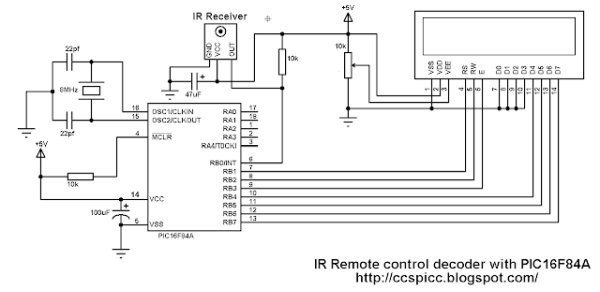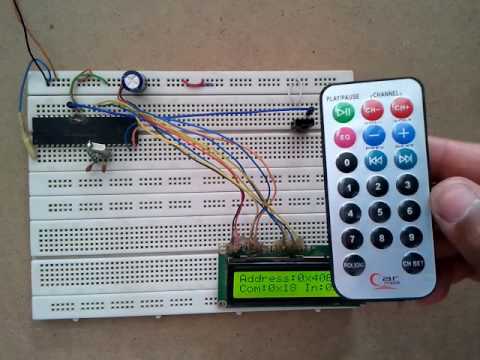Summary of NEC Remote control decoder with PIC16F84A
This article explains decoding the NEC protocol IR remote control signals using a PIC16F84A microcontroller. The NEC protocol uses pulse distance encoding with a 38KHz carrier frequency, sending logic 0 and 1 as different lengths of pulse bursts and spaces. The complete message consists of a 16-bit address and a 16-bit command (with the second command byte inverted for verification). The project uses a simple delay-based polling approach on the RB0 pin connected to the IR receiver output, avoiding interrupts or timers. The article includes a circuit schematic and CCS C code for decoding the NEC protocol with timing checks for the 9ms header burst, 4.5ms space, and data bits.
Parts used in the NEC Protocol IR Remote Control Decoder with PIC16F84A:
- Microchip PIC16F84A microcontroller
- IR receiver module (38KHz carrier frequency)
- Resistors (for IR receiver and microcontroller circuitry)
- Capacitors (for power stabilization and filtering)
- Crystal oscillator (for PIC16F84A clock)
- Connecting wires and breadboard or PCB
- Power supply (5V regulated)
The NEC protocol uses pulse distance encoding of the bits. Each pulse is a 562.5µs long with carrier frequency of 38KHz. Logic bits are transmitted as follows:
Logic 0: 562.5µs pulse burst followed by a 562.5µs space, with a total transmit time of 1125µs (562.5 x 2).
Logic 1: a 562.5µs pulse burst followed by a 1687.5µs (562.5 x 3) space, with a total transmit time of 2250µs (562.5 x 4).
It is easy to decode IR remote control uses NEC protocol using microcontrollers.
Here Microchip PIC16F84A microcontroller is used to decode IR remote controls which uses NEC and extended NEC protocol. Decoder circuit schematic is shown below. The following drawing shows an extended NEC message example.
There are different ways to decode the NEC protocol for example using CCP module and Timer, using Timer module or using port change interrupt. In this project I didn’t use any interrupt or Timer, I used delay command to make the code as simple as possible with time-out property and the code checks the IR signal with resolution of 50µs.
Programming hints:
From the decoder circuit schematic above the output of the IR receiver is connected to RB0 and when an IR signal is received RB0 pin goes from logic high (+5V) to logic low (0V).
The NEC message has 32 bits which are divided into address (16 bits), command (8 bits) and inverted command (8 bits).
The microcontroller waits until the IR receiver receives an IR signal which makes RB0 goes from logic high to logic low and the command used is:
while(input(PIN_B0));
After that a function named nec_remote_read() is called, this function checks if the received signal has NEC protocol form all the time.
The last function reads the 9ms burst using the following lines and if the pulse is more than 10ms (50µs x 200) or less than 8ms (50µs x 160) the function returns with false result which means the received signal doesn’t have NEC protocol form.

while((input(PIN_B0) == 0) && (count < 200)){
count++;
delay_us(50);}
if( (count > 199) || (count < 160))
return false;
The 4.5ms space is checked as the 9ms burst with small differences:
while((input(PIN_B0)) && (count < 100)){
count++;
delay_us(50);}
if( (count > 99) || (count < 60))
return false;
After that the microcontroller starts reading the 32 bits and keeps checking of NEC protocol form.
The following code is the complete CCS PIC C code written with compiler PCWHD version 5.051.

